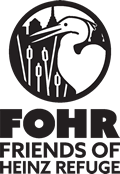The relationships developed by meeting and working through challenges with our community members are the foundation of the work we do...in a phrase, doing refuge from the community out.
Lamar Gore, Refuge Manager
Mission
Working with others to conserve, protect, and enhance fish, wildlife, and plants and their habitats for the continuing benefit of the American people.
The First Urban Refuge
Nestled in the urban setting of Philadelphia, John Heinz National Wildlife Refuge at Tinicum is America’s First Urban Refuge. It was established in 1972 for the purpose of preserving, restoring, and developing the natural area known as Tinicum Marsh, to promote environmental education, and to afford visitors an opportunity to study wildlife in its natural habitat.
The Heinz Refuge currently includes 993 acres of the 1,200 acres within its approved acquisition boundary. It protects over 200 acres of the largest remaining freshwater tidal marsh in Pennsylvania. Wetlands, like Tinicum Marsh, support a broad diversity of plant and bird species while also acting as a natural sponge and filter to prevent flooding and remove pollutants.
Over 150,000 people visit the refuge annually for environmental education programs, bird watching, hiking, kayaking, archery, fishing, and other outdoor recreation. The Heinz Refuge programs meet the Standards of Excellence for Urban National Wildlife Refuges by educating and engaging youth, engaging neighboring communities, creating corridors to nature, and bring nature into the city.
The refuge protects a variety of habitats for birds and has been designated as an Important Bird Area by the National Audubon Society. While most of the 300 plus avian species identified at the refuge utilize it as a migratory stopover, more than 80 species have been recorded nesting on the refuge over the years. Several species are also state listed as either threatened or endangered species or species of state or national management concern.
A Brief History
In the early 1600s, Swedish settlers made their first landfall in what is now called Tinicum Township, Pennsylvania. At the time, Tinicum Marsh comprised over 5,000 acres. The settlers immediately began to dike and drain the wetlands in order to create farms. Nevertheless, the bulk of the wetland acreage remained intact until the mid-1900s when the Corps of Engineers filled over 4,000 acres with dredge spoils from the nearby Delaware River. Ultimate plans for the area included industrial development.
In the 1960s and 1970s, two solid waste landfills were established in the marsh, a first step in the industrial development planning process. Concurrently, plans were implemented to build Interstate 95 right through Tinicum’s wetlands, resulting in massive dredging and filling, which further reduced Tinicum’s wetland acreage.
Local citizens, alarmed by these activities, formed a grassroots organization, simultaneously fighting to close the landfills, divert the highway, and persuade the United States Congress to designate the remaining wetlands of Tinicum Marsh as a National Wildlife Refuge.
The highway was diverted, the landfills were closed, and finally in 1972, the refuge was created by Congress.

